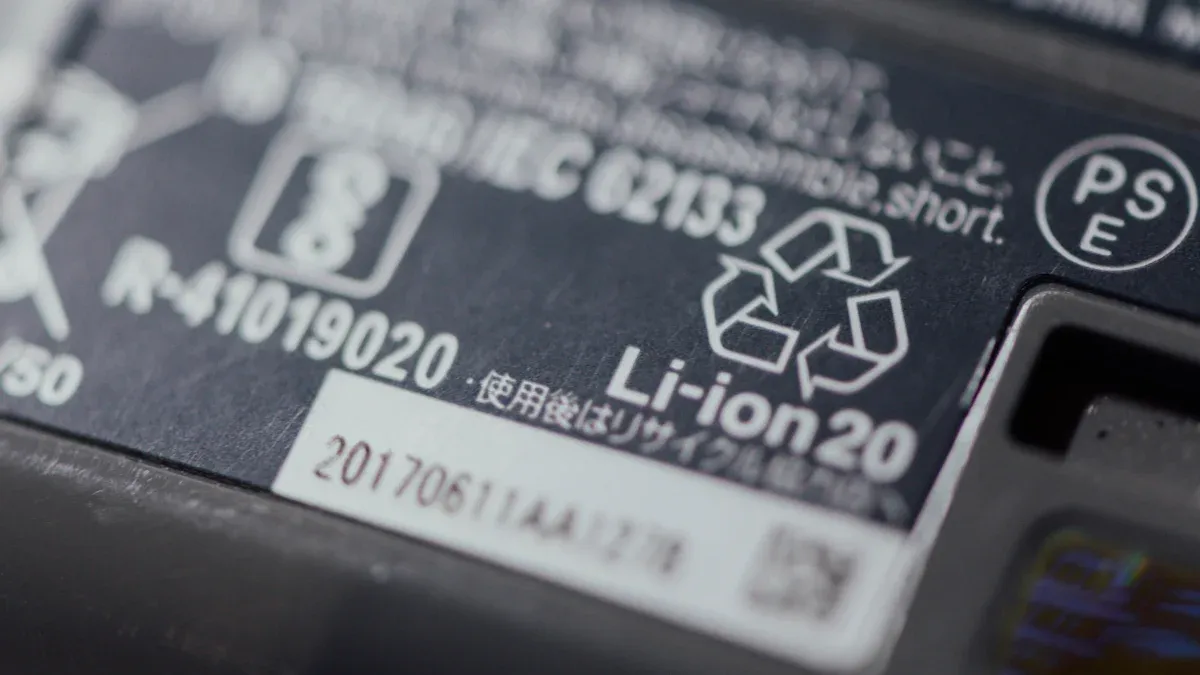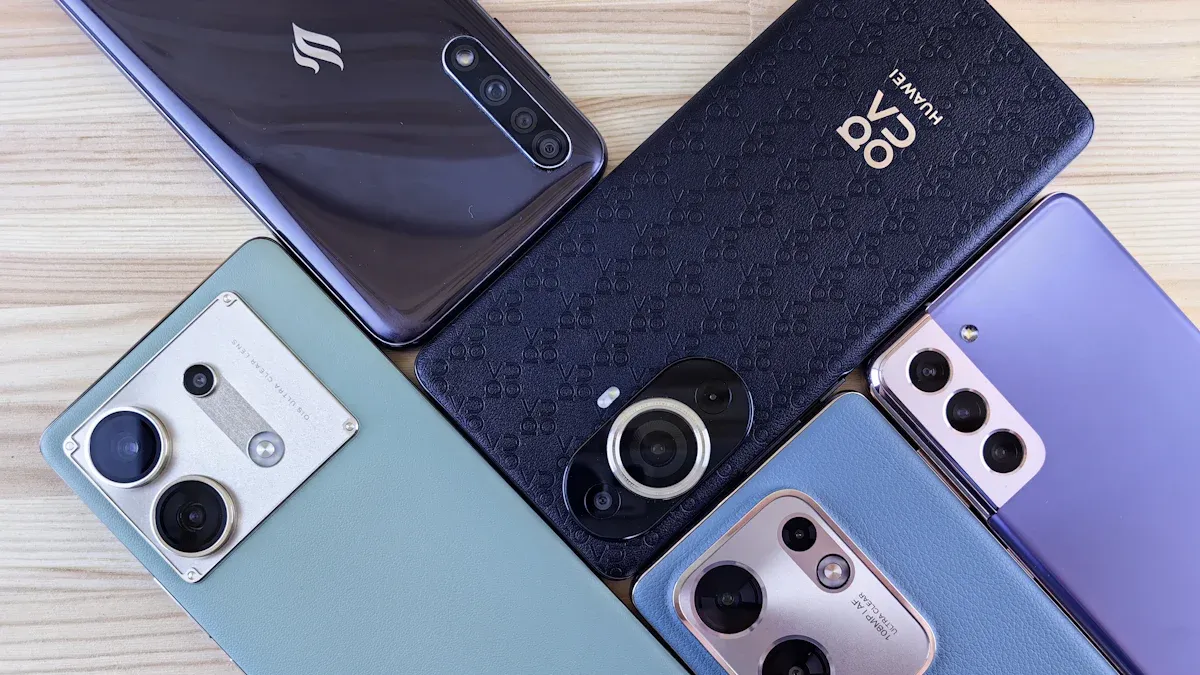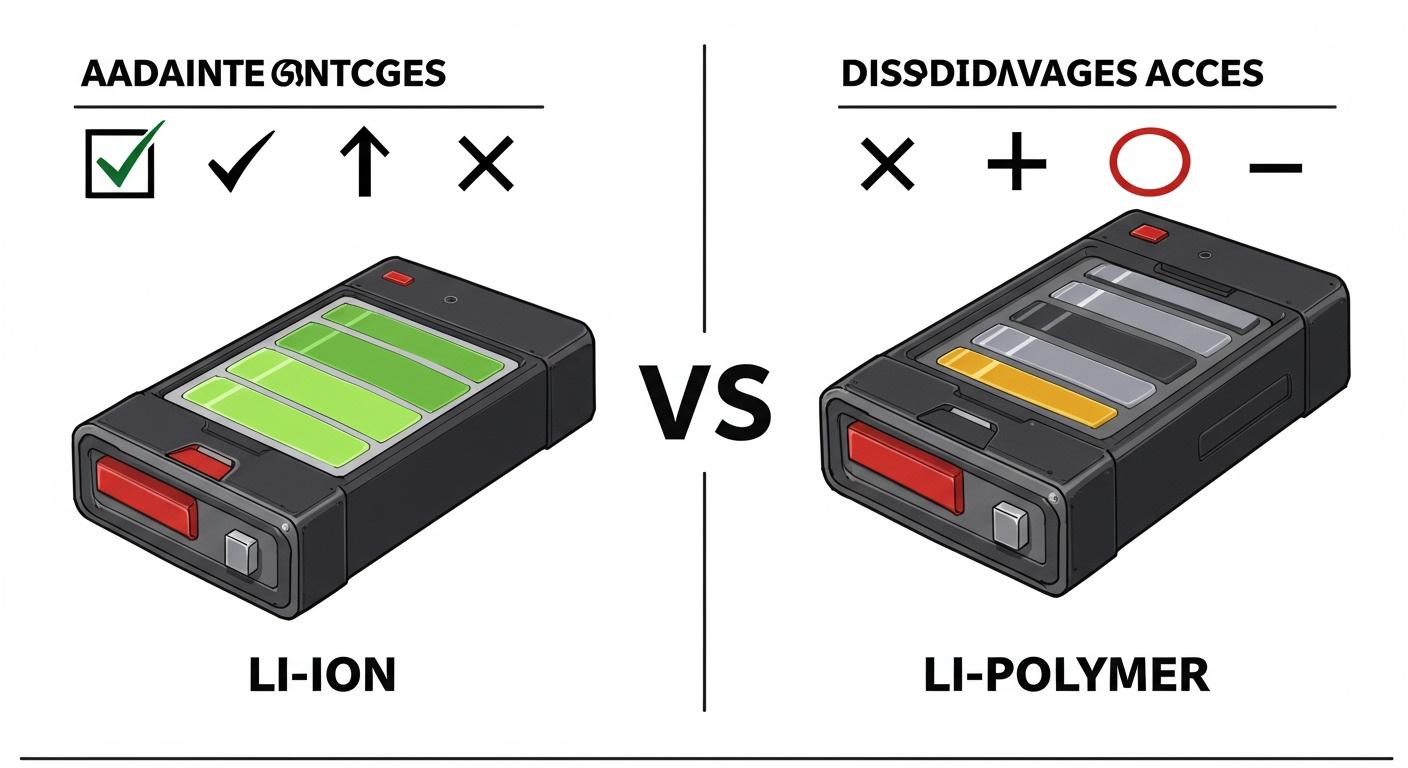The advantages and disadvantages of li-ion batteries and li-polymer batteries
When you compare lithium ion batteries and li-polymer batteries, you notice clear differences. Lithium ion batteries stand out for high energy density, long life, and low cost. However, you may face safety concerns and a rigid design. Li-polymer batteries offer lightweight, flexible shapes and improved safety, but you pay more and get less energy. The table below shows the main advantages of li-ion batteries and li-polymer batteries to help you pick the best fit for your needs.
| Battery Type | Main Advantages | Main Disadvantages |
|---|---|---|
| li-ion batteries | High energy, long lifespan, affordable | Safety, rigid, aging, pollution |
| li-polymer batteries | Light, flexible, safer, fast charging | Cost, lower energy, lifespan |
Key Takeaways
- Li-ion batteries are known for their high energy density, allowing devices to run longer without recharging.
- Li-polymer batteries are lightweight and flexible, making them ideal for slim or custom-shaped devices.
- Safety is a major concern with li-ion batteries, as they can overheat or catch fire if damaged.
- Li-polymer batteries charge quickly and have a low self-discharge rate, keeping devices powered for longer when not in use.
- Consider your device's needs: choose li-ion for cost-effectiveness and longevity, or li-polymer for flexibility and safety.
Advantages of li-ion batteries

High energy density
When you look for batteries that last longer and power your devices efficiently, high energy density stands out as one of the main advantages of li-ion batteries. You get more energy packed into a smaller and lighter battery. This means your phone, laptop, or tablet can run for hours without needing a recharge. Over the past 30 years, the energy density of lithium batteries has improved more than three times in both volume and weight. Some new batteries even target up to 450 Wh/kg, which is much higher than other types. Because of this high energy density, you can enjoy slim and lightweight devices without sacrificing performance.
Long lifespan
Another key benefit is the long lifespan of li-ion batteries. You can use your devices for years before you notice a drop in performance. The life of these batteries often outlasts other rechargeable options. This long lifespan means you do not have to replace your batteries as often, saving you time and money. The capacity of lithium batteries stays strong for many charge cycles, so your devices keep working well over time.
Cost-effective
You will find that the advantages of lithium batteries include being cost-effective. The price of li-ion batteries has dropped sharply, with the average cost expected to fall below $100 per kWh in 2024. This makes them affordable for most consumer electronics. Because of their low cost and high capacity, you get great value for your money. The cost savings add up, especially when you use devices that need frequent charging.
Widely available
Li-ion batteries are everywhere. You see them in smartphones, laptops, and tablets. In fact, over a billion smartphones, hundreds of millions of laptops, and millions of tablets use these batteries each year. The wide availability of lithium batteries makes it easy for you to find replacements or upgrades. This is one of the biggest advantages of li-ion batteries for consumer electronics. You can trust that your devices will have reliable power whenever you need it.
Tip: If you want a battery that offers high energy density, long lifespan, and is easy to find, li-ion batteries are a smart choice for most consumer electronics.
Disadvantages of li-ion batteries
Safety concerns
When you use lithium-ion batteries, you need to pay attention to overheating and safety risks. These batteries can catch fire or even explode if you damage them, overcharge them, or expose them to high temperatures. You may notice that some devices include special circuits to prevent these problems, but accidents still happen. Safety remains a major concern, especially in large battery packs or when you use batteries in harsh environments. This is one of the main drawbacks you should consider before choosing these batteries.
Rigid design
You might find that the rigid design of lithium-ion batteries limits your options. Most batteries come in hard, fixed shapes, which can make it difficult to fit them into slim or custom-shaped devices. If you want a battery for a flexible gadget or a device with a unique form, this design can be a real disadvantage. The lack of flexibility is one of the key drawbacks compared to other battery types.
Aging and capacity loss
Over time, you will see that lithium-ion batteries lose their ability to hold a charge. This process is called aging, and it affects the cycle life of your battery. Several factors can speed up this process:
| Factor | Effect on Aging |
|---|---|
| Fast Charging | Accelerates aging, leading to performance reduction |
| Dynamic Stress Cycling | Causes rapid cell degradation, reaching end-of-life |
| Li Plating | Identified as a significant degradation mechanism |
If you charge your batteries quickly or use them in devices that need frequent power changes, you may notice a drop in performance sooner. This aging process is one of the main disadvantages of lithium batteries.
Environmental impact
You should also think about the environmental impact of lithium-ion batteries. The production process uses a lot of energy and creates high CO2 emissions. Mining for materials like cobalt and lithium can harm local ecosystems and communities. Problems such as child labor and toxic chemical leaks from mining sites are common. Recycling rates for these batteries are still low, but new technology may help improve this in the future. Recycling lithium-ion batteries is crucial for sustainability, and the recovery rate can reach over 95%. Still, the current situation means these batteries have a significant environmental footprint.
Note: Always dispose of used batteries properly to help reduce environmental harm.
Advantages of li-polymer batteries
Lightweight and flexible
You will notice that li-polymer batteries stand out for their lightweight and flexible design. Most pouch cells use a soft, flat pouch instead of a hard metal case. This pouch allows you to fit batteries into slim, curved, or custom-shaped devices. If you want to design a wearable gadget or a thin smartphone, you can use these batteries to save space and reduce weight. The pouch structure also makes these batteries easier to stack, which helps you create compact electronics.
Enhanced safety
Li-polymer batteries offer improved safety compared to traditional lithium-ion batteries. You benefit from several built-in safety features:
- Pressure ventilation helps prevent explosions if the internal pressure rises too high.
- Some pouch cells use composite solid-state electrolytes with flame-retardant properties, which lower the risk of fire.
- The pouch design reduces the chance of thermal runaway, which can cause fires or explosions in other batteries.
These safety features make li-polymer batteries a smart choice for portable devices and applications where safety is a top priority.
Fast charging
You can enjoy fast charging with li-polymer batteries, which is important for devices that need quick power-ups. The pouch design supports high charging currents, and a good battery management system keeps the battery safe during fast charging. The table below shows how temperature and management affect charging efficiency:
| Factor | Explanation |
|---|---|
| Battery Management System | Ensures the battery is not overcharged and manages heat to maintain safe limits during fast charging. |
| 32ºC | Ideal for fast charging, enhancing charging speed and efficiency. |
You get fast charging efficiency when you use the right temperature and management system. This means you spend less time waiting for your device to recharge.
Low self-discharge
Li-polymer batteries have a very low self-discharge rate. You can leave your device unused for weeks, and the battery will still hold almost a full charge. The pouch structure uses a solid-state electrolyte called LiPON, which helps keep the self-discharge rate low. This high efficiency is important for long-term storage. You do not need to worry about losing power if you store your device for a long time. In fact, these batteries have a discharge to charge efficiency greater than 99%, much higher than standard lithium-ion batteries.
Tip: If you need batteries for custom devices, long-term storage, or fast charging, li-polymer pouch cells give you flexibility, safety, and top efficiency.
Disadvantages of li-polymer batteries
Higher cost
You may notice that li-polymer batteries often come with a high cost. Manufacturers use advanced materials and specialized designs, which increase production expenses. If you choose these batteries for your device, you might pay more compared to standard lithium-ion options. The extra cost can make li-polymer batteries less attractive for budget-friendly electronics. Many consumers prefer cheaper alternatives when price matters most.
Note: The high cost of li-polymer batteries can limit their use in mass-market products.
Lower energy density
Li-polymer batteries usually offer lower energy density than traditional lithium-ion batteries. This means you get less power from the same size or weight. If you need batteries for devices that require long runtimes or high performance, you may find li-polymer batteries less efficient. Here is a quick comparison:
- Li-polymer batteries and lithium-ion batteries share similar longevity and usage.
- Specific numerical energy density values are not always available, but li-polymer batteries generally provide less energy per unit than lithium-ion batteries.
Devices that need maximum power often rely on lithium-ion batteries instead.
Shorter lifespan
You might experience a shorter lifespan with li-polymer batteries in some consumer devices. The quality of materials and how you use the batteries affect how long they last. Most lithium batteries, including li-polymer types, can last between 5 and 15 years. However, frequent charging, high temperatures, and heavy use can reduce their lifespan. If you want batteries that last longer, you may need to consider other options.
- Li-polymer batteries may need replacement sooner than lithium-ion batteries in demanding applications.
- Proper care can help extend the lifespan, but usage patterns play a big role.
Complex manufacturing
Manufacturing li-polymer batteries involves complex processes. You need precise control over materials and assembly to ensure safety and performance. The flexible pouch design requires careful handling to prevent leaks or damage. This complexity can lead to higher production costs and longer development times. If you plan to use li-polymer batteries in custom devices, you should expect longer lead times and possible supply challenges.
Tip: Always check the quality and source of li-polymer batteries before purchasing for specialized projects.
Comparison

Comparison table
You can quickly see the main differences between li-ion and li-polymer batteries by looking at the table below. This table helps you compare important features, so you can choose the right battery for your needs.
| Feature | Li-ion Batteries | Li-polymer Batteries |
|---|---|---|
| Energy Density | High | Moderate to Low |
| Weight | Heavier | Lighter |
| Flexibility | Rigid (cylindrical, prismatic) | Flexible (pouch, prismatic) |
| Safety | Moderate | Enhanced |
| Cost | Lower | Higher |
| Lifespan | Longer | Shorter |
| Self-discharge | Moderate | Very Low |
| Charging Speed | Standard | Fast |
| Availability | Very Common | Less Common |
Note: You often find li-ion batteries in cylindrical cells and prismatic cells, while li-polymer batteries usually come in flexible pouch or prismatic cells.
Use cases
You need to match the battery type to your device or project. Each battery type fits different applications of lithium batteries. Here are some common use cases:
- Consumer electronics: If you use smartphones, laptops, or tablets, you likely use li-ion batteries. These devices need high energy density and long lifespan. Most manufacturers choose cylindrical cells or prismatic cells for these products.
- Wearable devices: You want a battery that is light and flexible for smartwatches or fitness trackers. Li-polymer batteries work best here. The prismatic or pouch design fits slim and curved shapes.
- Drones and RC models: You need fast charging and low weight for drones. Li-polymer batteries give you these features. The prismatic shape also helps reduce size.
- Medical devices: You often see li-polymer batteries in medical sensors and portable monitors. The flexible prismatic cells fit custom shapes and improve safety.
- Power tools: You need high power and durability for drills or saws. Li-ion batteries in cylindrical cells or prismatic cells deliver strong performance.
Tip: Always check if your device needs a rigid battery (cylindrical or prismatic) or a flexible one (pouch or prismatic). This helps you pick the best option for your application.
Electric vehicles
You see electric vehicles changing the way people travel. These vehicles rely on advanced batteries for power, range, and safety. Most electric vehicles use lithium-ion batteries because they offer high energy density and long lifespan. Manufacturers often use cylindrical cells and prismatic cells in electric vehicles. You find cylindrical cells in some electric cars because they are easy to cool and replace. Prismatic cells also appear in many electric vehicles because they save space and fit well in battery packs.
You notice that some electric vehicles use prismatic cells for better energy storage and safety. Prismatic cells allow you to design battery packs that fit the shape of the vehicle. This makes them popular in buses, trucks, and even motorcycles. Cylindrical cells remain common in electric vehicles that need high power and easy maintenance.
You rarely see li-polymer batteries in electric vehicles. These batteries have lower energy density and shorter lifespan. However, some small electric vehicles or scooters use li-polymer batteries with prismatic shapes for lightweight and flexible design.
If you plan to buy or build an electric vehicle, you should look for battery packs with cylindrical or prismatic cells. These options give you the best mix of safety, power, and lifespan.
You can see that the choice of battery shape—cylindrical or prismatic—affects the performance and design of electric vehicles. You should always consider your needs for range, safety, and cost before choosing a battery for your vehicle.
You have seen that li-ion batteries give you high energy and long life, making them great for most electronics and electric vehicles. Li-polymer batteries work best when you need a light, flexible shape or extra safety. Think about your device’s needs before you choose. If you want long use and low cost, pick li-ion. For slim or custom gadgets, li-polymer is a smart choice.
-

 May.2025.11.24Ternary Lithium Battery vs Lithium-ion: Complete Comparison Guide (2025 Edition)Learn More
May.2025.11.24Ternary Lithium Battery vs Lithium-ion: Complete Comparison Guide (2025 Edition)Learn More -

 May.2025.11.214S2P 18650 14.8V Battery: Complete Technical Guide, Specs, Applications & SafetyLearn More
May.2025.11.214S2P 18650 14.8V Battery: Complete Technical Guide, Specs, Applications & SafetyLearn More -

 May.2025.11.18PCM vs BMS in Lithium Batteries: What’s the Difference and Which One Do You Need?Learn More
May.2025.11.18PCM vs BMS in Lithium Batteries: What’s the Difference and Which One Do You Need?Learn More -

 May.2025.11.17Custom Li-ion Battery Design for Medical Devices (2025 Comprehensive Guide)Learn More
May.2025.11.17Custom Li-ion Battery Design for Medical Devices (2025 Comprehensive Guide)Learn More -

 May.2025.11.17The Future of Lithium-Ion Batteries: Innovation, Sustainability, and Global Market TrendsLearn More
May.2025.11.17The Future of Lithium-Ion Batteries: Innovation, Sustainability, and Global Market TrendsLearn More
















